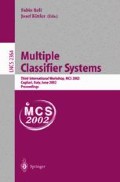Abstract
Parallels between Feature Extraction / Selection and Multiple Classification Systems methodologies are considered. Both approaches allow the designer to introduce prior information about the pattern recognition task to be solved. However, both are heavily affected by computational difficulties and by the problem of small sample size / classifier complexity. Neither approach is capable of selecting a unique data analysis algorithm.
Access this chapter
Tax calculation will be finalised at checkout
Purchases are for personal use only
Preview
Unable to display preview. Download preview PDF.
References
Raudys S. On the problems of sample size in pattern recognition. In: Pugatchiov V.S. (editor) Detection, Pattern Recognition and Experiment Design, Proceedings of the 2nd All-Union Conference Statistical Methods in Control Theory. Nauka, Moscow. 2:64–76 (in Russian), 1970.
Kanal L. and Chandrasekaran B. On dimensionality and sample size in statistical pattern classification. Pattern Recognition 3:238–55, 1971.
Vapnik V.N. and Chervonenkis D.Ya. Theory of Pattern Recognition: Statistical learning problems. Nauka, Moscow (in Russian), 1974.
Geman S.L., Bienenstock E., Doursat R. Neural networks and bias/variance dilemma. Neural Computation 4:1–58, 1992.
Raudys S. Statistical and Neural Classifiers: An integrated approach to design. Springer, London, 2001.
Kittler J. and F. Roli (eds.). Multiple Classifier Systems. Springer Lecture Notes in Computer Science, Springer Vol. 1857 (2000), Vol. 2096, 2001.
Ho T.K. Data complexity analysis for classifier combination. Multiple Classifier Systems. Springer Lecture Notes in Computer Science, Springer Vol. 2096(2001): 53–67.
Raudys A., Long J. A.. MLP based linear feature extraction for nonlinearly separable data, Pattern Analysis & Applications, 4(4): 227–34, 2001.
Ripley B.D. Pattern Recognition and Neural Networks. Cambridge University press, Cambridge, 1996.
Tubbs J.D., Coberley W.A., Young D.M. (1982) Linear dimension reduction and Bayes classification with unkown parameters. Pattern Recognition 14(3):167–172, 1982.
Haykin S. Neural Networks: A comprehensive foundation. 2nd edition. Prentice-Hall, Englewood Cliffs, NJ, 1999.
Duin R.P.W. Classifiers for dissimilarity-based pattern recognition. Proc. 15 th Int. Conf of Pattern Recognition. IEEE press, Los Alamitos, 2: 1–7, 2000.
Raudys S and Tamosiunaite M. Biologically inspired architecture of feedforward networks for signal classification. Advances in Pattern Recognition. Ferri F, Pudil P (eds). Springer Lecture Notes in Computer Science. Vol. 1876, pp. 727–736, 2000.
Giacinto G. and Roli F. Dynamic classifier selection based on multiple classifier behaviour. Pattern Recognition, 34(9):179–181, 2001.
Kuncheva L.I., Bezdek J.C. Duin and RP.W. Decision templates for multiple classifier fusion: and experimental comparison. Pattern Recognition 34: 299–314, 2001.
Fukunaga K. Introduction to Statistical Pattern Recognition. 2nd edition. Academic Press, New York, 1990.
Roli F., Raudys S. and Marcialis G.L. An experimental comparison of fixed and trained fusion rules for crisp classifiers. In: Kittler J. and F. Roli (eds.). Multiple Classifier Systems. Springer Lecture Notes in Computer Science, Springer, 2002.
Pikelis V. Calculating statistical characteristics of experimental process for selecting the best version. In: Raudys S. (ed.) Statistical Problems of Control, 93:46–56. Institute of Mathematics and Informatics, Vilnius (in Russian) 1991.
Raudys S. Influence of sample size on the accuracy of model selection in pattern recognition. In: S Raudys S.(ed.), Statistical Problems of Control, 50:9–30. Institute of Mathematics and Informatics, Vilnius (in Russian), 1981.
Janeliunas A. and Raudys S. Reduction of the boasting bias of linear experts. In: Kittler J. and F. Roli (eds.). Multiple Classifier Systems. Springer Lecture Notes in Computer Science, Springer, 2002.
Raudys S. Experts’ bias in trainable fusion rule. IEEE Transactions on Pattern Analysis and Machine Intelligence (2001, submitted).
Güler C., Sankur B., Kahya Y., Skurichina M., Raudys S. Classification of respiratory sound patterns by means of cooperative neural networks. In: G. Ramponi, G.L. Sicuranza, S. Carrato, S. Marsi (editors), Proceedings of 8th European Signal Processing Conference (isbn 88-86179-83-9). Edizioni Lint, Trieste, 1996.
Wolpert D.H. Stacked generalization. Neural Networks 5: 240–259, 1992.
Somorjai R.L., Dolenko B., Nikulin A., Nickerson P., Rush D., Shaw A., de Glogowski M., Rendell J., Deslauriers R. Distinguishing normal allografts from biopsy-proven rejections: application of a three-stage classification strategy to urine MR and IR spectra. Vibrational Spectroscopy 28:(1) 97–102, 2002.
Schulernd H. The influence of feature selection on error estimates in linear discriminant analysis. IEEE Transactions on Pattern Analysis and Machine Intelligence (2002, accepted).
Somorjai R.L, Janeliūnas A, Baumgartner R., Raudys S. Comparison of two classification methodologies on a real-world biomedical problem: A feature-extraction-based 3-stage strategy vs. the strategy of classifier complexity regularization and multiple classifier systems. Advances in Pattern Recognition (Proc. SPR+SSPR’2002, Duin R.P.W. and Kamel M., eds.). Springer, Lecture Notes in Computer Science, 2002.
Author information
Authors and Affiliations
Editor information
Editors and Affiliations
Rights and permissions
Copyright information
© 2002 Springer-Verlag Berlin Heidelberg
About this paper
Cite this paper
Raudys, Š. (2002). Multiple Classification Systems in the Context of Feature Extraction and Selection. In: Roli, F., Kittler, J. (eds) Multiple Classifier Systems. MCS 2002. Lecture Notes in Computer Science, vol 2364. Springer, Berlin, Heidelberg. https://doi.org/10.1007/3-540-45428-4_3
Download citation
DOI: https://doi.org/10.1007/3-540-45428-4_3
Published:
Publisher Name: Springer, Berlin, Heidelberg
Print ISBN: 978-3-540-43818-2
Online ISBN: 978-3-540-45428-1
eBook Packages: Springer Book Archive

